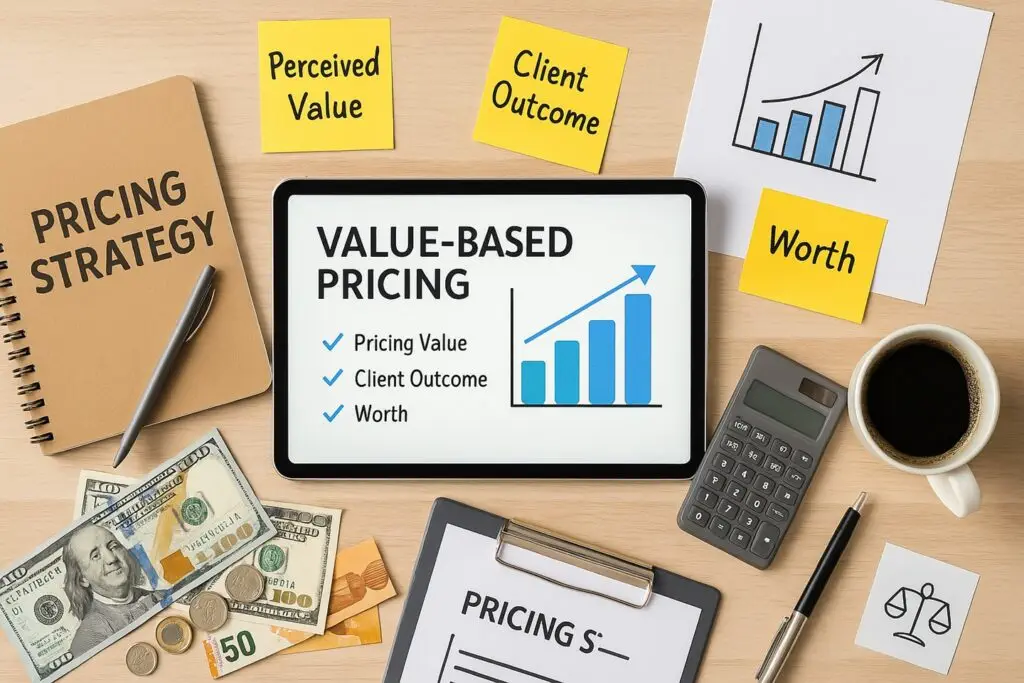Setting the right price for your products or services is one of the most critical business decisions you’ll make. Value-based pricing is a strategy that shifts the focus away from simple cost calculations or market averages and puts the spotlight on the true worth your work brings to your customers. This approach is especially powerful for freelancers, small business owners, and digital agencies who offer unique, results-driven services or solutions.
With value-based pricing, you charge based on how much your client perceives your service or product is worth, not just what it costs you to deliver. Getting paid what you’re truly worth requires a confident and strategic approach—but those who use it often build stronger client relationships and higher profits. Plus, it aligns closely with smart invoicing and modern billing systems, which streamline the entire process. To see how pricing and invoicing technology go hand-in-hand, check out The Benefits of Using Invoice Software vs Invoice Templates.
What Is Value-Based Pricing?
Value-based pricing means setting your price based on the perceived value to your customer, rather than on your costs or the average market price. Unlike cost-based pricing—which focuses on materials, labor, and a markup—value-based pricing is centered on the benefits and results delivered. For example, two brands of milk might have identical production costs, but one can command a premium because customers feel it’s healthier, more sustainable, or simply better tasting.
- Cost-based pricing: Calculates price by adding up all costs and adding a standard profit margin.
- Hourly or fixed-price billing: Charges based on time spent or set deliverables, regardless of perceived client value.
- Value-based pricing: Focuses on the outcomes, transformation, or utility that the client gains, allowing for higher prices when the service or product delivers exceptional results or unique value.
This approach answers a fundamental question: How much is the client willing to pay for the value you’re providing? Implementing this pricing strategy means understanding and communicating the real-world impact of your work. If you want to see how value delivery and efficiency go together, see Why Invoice Software is More Viable than Invoice Templates.
Value-Based Pricing vs. Cost-Based Pricing
To grasp value-based pricing, it’s helpful to contrast it with the traditional cost-based approach. In cost-based pricing, the process looks like this:
- Calculate total costs of production, including time, materials, and overhead.
- Add a standard markup or profit margin.
- Resulting in a cost-plus pricing model—simple but often separated from customer perceptions of value.
Value-based pricing is different. Here, you:
- Assess the value delivered to the client (such as revenue generated, time saved, or competitive advantage).
- Set your price point based on this value, which can significantly exceed the simple cost of delivery.
Cost-based pricing is common in industries where differentiation is low—think commodities or standard services. Value-based strategies thrive when you offer something unique, solve a critical problem, or create clear advantages for your clients. Tools and technology can help business owners consistently create, deliver, and justify their value. For instance, leveraging comprehensive digital tools is an important part of staying competitive and profitable in this landscape.
How Does Value-Based Pricing Work?
Putting value-based pricing into practice isn’t guesswork—it’s a process that begins with understanding what your customers truly value. Here’s how it works:
- Identify the features and outcomes your customers care about most. Is it time-saving? Increased revenue? Unique expertise?
- Gauge perceived value through direct conversations, testimonials, or feedback surveys. Dive deep into what clients appreciate most and what makes you different.
- Establish a value proposition. Articulate in simple terms what clients get from working with you—and how it translates to meaningful results.
- Set your value-based price point. Factor in both tangible gains (e.g., money saved or earned) and intangible benefits (e.g., peace of mind, reliability).
The core question remains: What is your offering worth to the client? The better you understand and communicate this, the more success you’ll see. For tips on making your value clear and visible, see this step-by-step guide for freelancers on professional, branded invoicing.
Key Components of a Value-Based Pricing Strategy
Building a winning value-based pricing strategy involves several essential steps:
- Market research: Analyze competitors, client behavior, and industry standards to reveal what’s truly valued and how much people pay for it.
- Customer feedback: Continuously seek input from past, present, and potential clients to understand which features or outcomes matter most.
- Analyzing customer data: Use analytics to identify patterns, top-performing services, and recurring pain points solved by your solutions.
- Understand your target market: What are their biggest challenges? Where are they willing to invest for results or transformation?
- Determine what customers are willing to pay: Approach this using direct conversations, A/B testing different packages, or surveying current clients.
- Communicate your unique value: Be precise and confident about what sets you apart from similar providers.
Every successful value-based pricing strategy links to measurable business goals. To help track the impact, don’t miss Essential Financial Metrics Every Small Business Owner Should Track.
Value-Based Pricing and Your Pricing Model
Integrating value-based pricing into your existing pricing model requires flexibility—especially if you already sell a mix of products and services.
- Consider offering tiered pricing models, allowing clients to choose from packages that align with the value they perceive and their budget.
- Combine fixed pricing and value pricing for different offerings, particularly if some are standardized and others deliver unique results.
- Continuously reassess your value proposition as your offerings evolve.
The right pricing approach helps you maximize profit and customer satisfaction. For more ways to package and present your value to customers, explore the Packages feature in the Invoice Crowd platform, which enables flexible product and service listings tailored to value-based approaches.
When Should You Use Value-Based Pricing?
Value-based pricing is most effective when:
- Your product or service is unique, highly differentiated, or delivers tangible results.
- Clients value expertise, creativity, or transformative outcomes—common in marketing, design, consulting, and technology.
- The target audience is less price-sensitive and more focused on value, ROI, exclusivity, or brand reputation.
- You have established brand loyalty and a track record of delivering higher value than the competition.
If you’re not sure your audience is value-focused, look for signs: Are your clients repeat buyers? Do they recommend your services to others? Are they willing to pay a premium for better results? Agencies, in particular, can thrive with value-based pricing strategies. For more insight on balancing creativity and business goals, read this article for digital marketing agencies.
Cons of Value-Based Pricing
While value-based pricing offers many benefits, there are potential challenges to consider:
- Time and expertise required: Conducting thorough market research and customer analysis takes significant effort.
- Risk of overestimating willingness to pay: Setting prices too high can alienate your audience; too low and you leave money on the table.
- Difficulty with new or commodity products: If you don’t have differentiation or strong evidence of unique value, this strategy may be harder to implement.
- Consistent reassessment needed: Customer perceptions and the market can change, so regular analysis and adaptation are key.
Weigh all factors carefully before making big pricing shifts—and remember, many business inefficiencies also come from neglecting key operations. For a broader look at how avoiding necessary business tools can hurt you, see The Hidden Cost of Avoiding an Invoicing Program.
Step-by-Step: How to Implement a Value-Based Pricing Strategy
Ready to move toward a value-based pricing model? Here’s a step-by-step process to get you started:
- Conduct market research. Investigate your competitors, industry best practices, and how customers currently perceive value in your niche.
- Analyze customer data. Identify the services/products that deliver the most impact and satisfaction.
- Assess your current value delivered. Gather testimonials, case stories, and feedback to understand what your clients gain from your work.
- Set your value-based price point. Use all available information to determine what your target market will pay for your unique offering.
- Clearly communicate your value. Update your proposals, marketing materials, and invoices to showcase outcomes, not just deliverables.
- Collect and use feedback. Regularly ask clients if your pricing matches the value they receive, and adjust accordingly.
- Monitor your profit margin and market share. Use reporting tools to track revenue growth, customer retention, and overall business health.
Leveraging technology—like automated billing, customizable invoices, and in-depth reporting—removes friction from adjusting and justifying your prices. Platforms with robust reporting, such as the Generate Reports feature, help you keep an eye on performance and optimize your strategy over time.
Value-Based Pricing vs. Hourly Billing and Other Models
Many professionals start with hourly billing or flat rates, but these approaches have built-in limitations:
- Hourly billing: Pays you for time spent, not impact delivered, potentially capping your earning potential and devaluing efficiency or expertise.
- Flat rates: Can simplify billing but may not reflect the real value—especially for transformative or high-impact projects.
By contrast, value-based pricing:
- Focuses on what the business achieves for the client (e.g., growth, savings, innovation).
- Rewards results and problem-solving skills—often allowing you to charge what you’re truly worth.
- Creates more meaningful conversations with clients around outcomes instead of deliverables or hours.
For tips on getting paid faster and communicating value in your billing process, review 10 Invoicing Tips That Can Help Your Business Get Paid Faster.
Use Cases: Value-Based Pricing in Action
Let’s explore a few common use cases where value-based pricing delivers transformative results:
- Freelancers and agencies: Rather than charging by the hour, set prices based on the revenue boost, time savings, or competitive edge your projects provide.
- SaaS companies: Offer plans and packages tied to features that directly impact the client’s business, such as automation, integrations, or analytics.
- Consulting: Bill according to the value of the strategy or growth enabled, not just consulting hours logged.
A strong use case: a creative agency transitions from rate-based billing to value-based proposals, customizing packages for unique needs and demonstrating ROI through clear outcomes. With the right tools, like a Proposal Builder, it’s easier to create, present, and deliver value-centered proposals to clients. This shift can set businesses apart, help charge higher rates, nurture brand loyalty, and strengthen client relationships.
Conclusion: Grow Your Business with Value-Based Pricing
Value-based pricing is more than a strategy—it’s a business mindset that acknowledges your expertise, experience, and the unique outcomes you deliver. By charging what you’re truly worth, you position your business for stronger profit margins, customer loyalty, and growth. Remember, pricing is the most powerful tool you have to shape perception, attract your ideal clients, and reflect the real value you bring.
If you’re ready to transition to a value-based pricing model, a modern invoicing platform can simplify your billing, showcase value, and help you manage flexible pricing strategies. Explore all the features that can support your move to a value-based, future-ready business.


